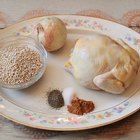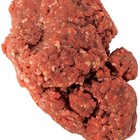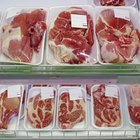
EzumeImages/iStock/Getty Images
For many people, eating well means much more than simply consuming two or three square meals a day: it means choosing foods that are low-fat, nutrient dense and rich in disease-fighting compounds as well as being affordable, easy to prepare and earth-friendly. Both chicken and quinoa, a seed native to the South American Andes Mountains, are popular lean protein choices among health-conscious eaters; however, a comparison of the two reveals a number of differences that can help you determine if one is a better protein source for your nutritional needs and personal philosophy.
Nutrition
A single serving of cooked quinoa -- approximately 1 cup -- contains 8 g of protein, 40 g of carbohydrates, 5 g of fiber and only 3.5 g of fat, none of which comes from saturated fat. By contrast, a 4 oz. portion of skinless chicken breast provides 31 g of protein, no carbohydrates or fiber, about 4 g of fat -- including some saturated fat -- and about 21 percent of the daily recommended intake of cholesterol. Both quinoa and chicken contain significant amounts of essential vitamins and minerals like folate, magnesium, phosphorus, iron, copper and manganese. While quinoa provides protein and vitamins with little fat, its protein is incomplete without other amino acid sources in the diet and it does not provide the same high amounts of zinc, riboflavin and vitamin B-12 that chicken does.
Affordability
In a pound by pound comparison, quinoa is significantly less expensive than chicken. According to Vegan Mainstream, a site that promotes the vegan lifestyle, replacing meat-based meals with menus centering around fruits, vegetables, legumes and grains like quinoa can decrease the overall amount you spend on food. However, organic brands of quinoa will cost more per pound, as will organic or free range chicken.
Versatility
Quinoa can be stored for up to one year in an airtight container placed in a dark cabinet or closet. It can be eaten by vegetarians, vegans and by people suffering from wheat or gluten sensitivities. Quinoa cooks quickly -- less than 15 minutes -- and has a flavor mild enough to lend itself to infinite variations: it can be mixed with spices, vegetables and sauces or serve as a base for stews, braises or other dishes. Chicken is also versatile, but it cannot be stored as long as quinoa, it isn't an option for vegetarians and vegans and, if not cooked and handled properly, can harbor bacteria like salmonella, campylobacter jejuni, listeria monocytogenes and staphylococcus aureus.
Environmental Impact
The growing meat industry, including the poultry industry, places extreme demands on the environment. Farms and production factories dealing with meat use large amounts of fossil fuel energy, produce greenhouse gases and chemicals that contaminate water supplies and lead to the destruction of native forests as larger tracts of land are needed to produce enough grain and corn to feed the animals used for meat. According to the New York Times, if Americans ate 20 percent less meat, greenhouse gas levels would decrease significantly. As the seed of a plant, quinoa requires much less fuel and land to produce than chicken.
Related Articles

Benefits of GMO Foods
Can I Grind Quinoa?

Staple Foods in Africa
Toppings for Quinoa

What Is the Difference Between Eating ...

What Do the Amish Feed Their Chickens?

How to Store Quinoa

How to Cook Moghrabieh

How to Save Cooked Quinoa

Difference Between Fryer & Roaster ...

Zinc & Copper for Aging Skin

How to Cook Moose Meat

Does It Take Longer to Cook With the ...

How to Bake Chicken Breast Without Oil

Advantages of Vermicompost

Dangers of Spoiled Ground Beef

Hydroponic Vegetable Nutrients Vs. ...

Fat in Whole Chicken vs. Chicken Breast

How to Cook Pork Loin

How to Feed a Large Family Healthy ...
References
Resources
Writer Bio
Michelle Kerns writes for a variety of print and online publications and specializes in literature and science topics. She has served as a book columnist since 2008 and is a member of the National Book Critics Circle. Kerns studied English literature and neurology at UC Davis.
Photo Credits
EzumeImages/iStock/Getty Images